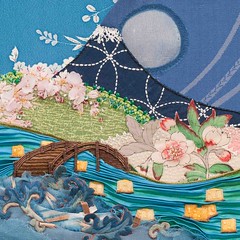
One, you get very, very good at the mechanics of transferring the pattern.
Two, the pattern becomes imprinted on your brain, kind of like a practice-run, so when it comes to stitching the goldwork...you have a good idea where you're heading because you've already been there. My teacher also has us trace the pattern before we begin...so transferring the pattern is actually the second time you've re-hearsed the pattern.
Which leads me to the third; you have plenty of time to reflect.
 Last week, a friend overheard me talking about Japanese embroidery. She had heard me mention that the actual pieces that I create in Japanese embroidery aren't necessarily what I would "choose" to stitch.
Last week, a friend overheard me talking about Japanese embroidery. She had heard me mention that the actual pieces that I create in Japanese embroidery aren't necessarily what I would "choose" to stitch.She heard me say that the only reason I was stitching them was because they are required in order to graduate from Japanese embroidery. I would really prefer to stitch designs that have more personal meaning for me. And the "graduation" part of Japanese embroidery? That has never has been a driving factor for me...as evidenced by the fact that I've been on and off Japanese embroidering for over 20 years and still haven't graduated...
"Why then," my friend asks, "do you study Japanese embroidery at all? Do you think you'll keep doing it once you graduate?"
It's a good question and so I answer it here just in case there is someone out there who may decide to study Japanese embroidery even though the projects themselves may not appeal.
So here it goes...
1. I am a much better embroiderer because of Japanese embroidery, plain and simple.

When he wrote it, George Leonard had been teaching the Japanese martial art of Aikido for over 35 years. In this short but powerful book, he prescribes a guide for anyone wishing to attain mastery in any area of life.
It's often those individuals who embrace hard work, who show up regularly, and who keep showing up over long stretches even when they may not be making any remarkable progress. Leonard calls these times of stagnation, plateaus...and he finds that it is on those plateaus that real masters are made.
Masters learn to love the plateaus. Find a master of any game and you'll likely find a master of practice.
Not since my mother died have I found a person willing to give me honest feedback and who has my best interest at heart. My teacher wants me to succeed, she wants me to master embroidery and she is there to help guide me. Often Tonie will mention with a sense of pride, that many of her students are better stitchers than she herself. I'm not so sure if that's true but it demonstrates Tonie's unflinching belief in her students' work.

As you round a curve, couching stitches need to be closer together...but it will look better if the spacing is consistent from shape to shape.
Many of the students that continue to come to Tonie's studio for classes are exceptional embroiderers who have adopted the lifelong learning approach to Japanese embroidery. Their wisdom and humility are constant sources of inspiration to me. Many of these women have achieved levels of mastery themselves yet they still consider themselves students. That's a lesson in and of itself.
I do not study Japanese embroidery in order to finish the pieces and hang them on my wall. The Japanese embroidery projects upon which I stitch are a means to an end. They are my practice pieces; my workout spaces.
I hope my honest answer to why I study might give some a few reasons to consider the study of Japanese Embroidery. All of these needlework traditions are at risk if there aren't new students to take them up.
If you'd like to give Japanese Embroidery a try, Tonie teaches here in Maryland but she has students from neighboring states , some coming from as far away as Canada. You can contact Tonie at tejapaneseembroidery (at) gmail (dot) com for more information.
The Japanese Embroidery Center in Atlanta is another place to learn and they can put you in contact with teachers from all over the world.






































